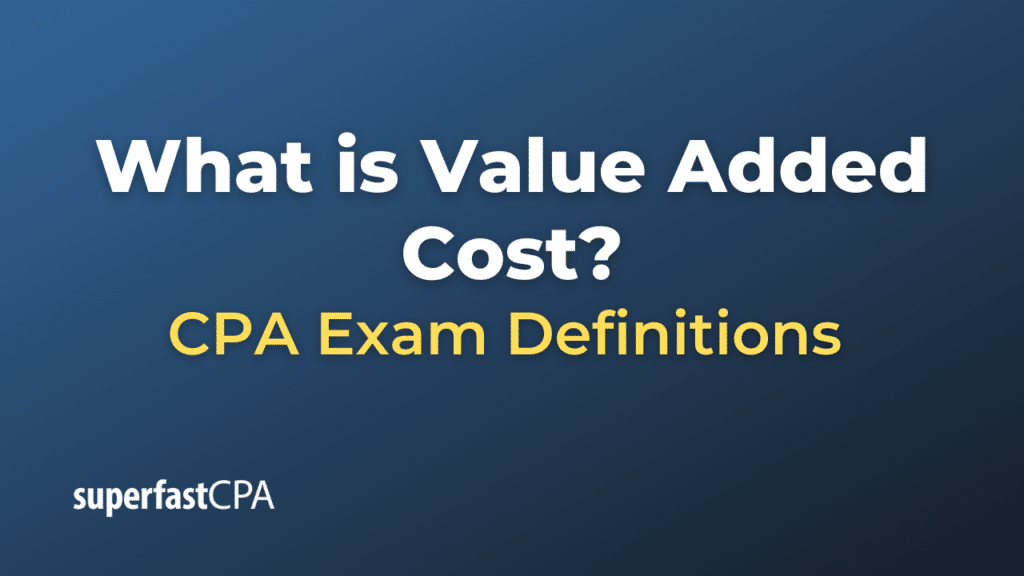Value Added Cost
The term “Value Added Cost” refers to the expenses associated with activities that directly contribute to creating value in the production of goods or services. In other words, these are the costs associated with value-added activities that enhance the product or service from the customer’s perspective. These are the activities for which customers are willing to pay because they add value to the final product or service.
Value-added costs stand in contrast to non-value-added costs, which are the costs incurred for activities that do not contribute directly to the value of the product or service, such as waste, inefficiency, or redundancy.
Categories of Value Added Cost:
- Material Costs: The cost of raw materials used in making the product.
- Labor Costs: Wages and benefits paid to employees who are directly involved in the production or service delivery.
- Overhead: Some elements of overhead can be value-added if they are essential to the production process, such as quality control, utilities for running machinery, etc.
- Research and Development: The cost of developing new products or improving existing ones that will attract more customers.
- Packaging: The cost of materials and labor for packaging that enhances the product’s value by making it easier to use, store, or transport.
Importance:
Understanding value-added costs can help businesses focus their resources more effectively. By identifying and maximizing value-added activities while minimizing non-value-added activities, a business can increase its profitability, improve efficiency, and better meet customer needs.
In summary, “Value Added Cost” encapsulates the financial investment made by a company in activities that directly contribute to making a product or service more valuable to the customer. This concept is central to improving efficiency and profitability in a business operation.
Example of Value Added Cost
Let’s consider a fictional pizza restaurant named “Tony’s Pizzeria” to illustrate the concept of value-added costs.
Tony’s Pizzeria Example
Tony owns a small pizzeria where he sells a variety of pizzas, salads, and beverages. He wants to understand the value-added and non-value-added costs associated with making and selling a single pizza.
Cost Breakdown for Making One Pizza:
- Ingredients: Flour, cheese, tomato sauce, toppings – $3 (Value Added)
- Labor: Chef’s and assistant’s time to make the pizza – $2 (Value Added)
- Utilities: Cost of electricity and gas for cooking – $0.50 (Value Added)
- Quality Control: Checking to make sure the pizza meets quality standards – $0.20 (Value Added)
- Packaging: Cost of the pizza box – $0.30 (Value Added)
- Storage: Cost of storing ingredients in a refrigerator – $0.40 (Non-Value Added)
- Waste: Cost related to spoiled ingredients – $0.10 (Non-Value Added)
Calculating Value Added Costs:
The total value-added cost for making one pizza would be:
- Ingredients: $3
- Labor: $2
- Utilities: $0.50
- Quality Control: $0.20
- Packaging: $0.30
Total Value Added Cost = $3 + $2 + $0.50 + $0.20 + $0.30 = $6
Calculating Non-Value Added Costs:
The non-value-added costs would be the cost of storage ($0.40) and the cost of waste ($0.10).
Total Non-Value Added Cost = $0.40 + $0.10 = $0.50
Actions Taken:
After identifying these costs, Tony realizes that the storage and waste are not adding value to his pizzas from the customer’s perspective. As a result, he:
- Implements just-in-time inventory management to reduce storage costs.
- Introduces more efficient ingredient utilization techniques to minimize waste.
By focusing on reducing non-value-added costs and optimizing value-added activities, Tony aims to enhance the profitability of his pizzeria while still delivering high-quality pizzas that satisfy his customers.
Understanding value-added costs helps Tony focus his resources on what truly matters for customer satisfaction and business profitability. By honing in on these aspects, he can make informed decisions on how to optimize his operations.













